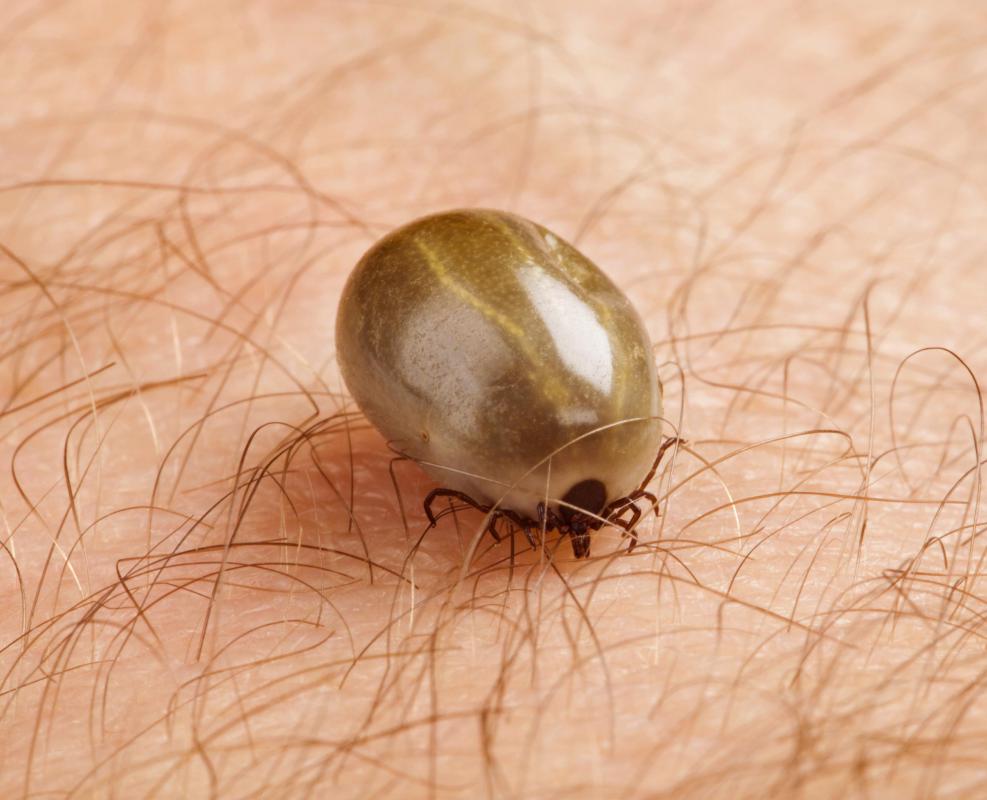At WiseGEEK, we're committed to delivering accurate, trustworthy information. Our expert-authored content is rigorously fact-checked and sourced from credible authorities. Discover how we uphold the highest standards in providing you with reliable knowledge.
What is Southern Tick Associated Rash Illness?
Southern Tick Associated Rash Illness (STARI) is a condition that may mimic Lyme disease, though the same types of ticks do not cause it. The offending tick which transmits this condition is called the Lone Star Tick (Ablyomma Americanum). Females have a small white spot on their back and are reddish brown in color. The Lone Star Tick is found in much of the Southeastern US, with a few pockets of these pests found in Northeastern states like New Jersey and Rhode Island. This breed has also been found as far west as the Lone Star State (Texas), though it is less common there. It may be found on deer, cattle, birds or rodents, in addition to biting the occasional human.
The principle reason that Southern Tick Associated Rash Illness raises concern is because it causes the same type of bullseye rash that is commonly found in Lyme disease. The rash appears along the same timeline as the bullseye rash in Lyme, about a week after a bite. In appearance, the rash is formed around the tick bite and can reach a diameter of about three inches (7.62 cm).

The early symptoms of Lyme disease may be the same as Southern Tick Associated Rash Illness. In addition to having the characteristic rash, people may feel achy, have headaches, feel fatigued or exhibit slight fevers. Yet unlike Lyme disease, these symptoms then resolve. They don’t tend to progress to the more extensive symptoms of late stage or chronic Lyme Disease. Symptoms may even be avoided if antibiotics are given, though according to the Centers for Disease Control and Prevention (CDC), it’s not always clear what specific bacteria causes Southern Tick Associated Rash Illness.

From a medical standpoint, it is important to differentiate one form of illness from the other, so anyone with a bullseye rash following a tick bite should be tested for Lyme disease. Both illnesses tend to be cured with antibiotics, but a longer antibiotic course may be required with Lyme disease than is needed for STARI. Better yet is to test the tick, since Southern Tick Associated Rash Illness is only known to be transmitted by the Lone Star Tick, which does not transmit Lyme. Identifying the tick can help dictate treatment.
Some people will develop the rash only, and won’t have other symptoms. Others appear to be in the throes of Lyme disease, especially when rash and other flu-like symptoms occur. Generally people are less sick, and the disease does not progress to a chronic condition when left untreated. Nevertheless, since Lyme bearing ticks and the Lone Star tick may be present in the same environment, have this rash checked out immediately by a physician, and if you do notice a tick attached to you, carefully detach it and have it tested for Lyme, and other conditions that may arise from tick bites like babesiosis and ehrlichiosis.
AS FEATURED ON:
AS FEATURED ON:












Discussion Comments
@Eviemae - I live in an area that has seen many cases of Lyme Disease caused by tick bites, and our doctors almost always seem to treat the illness quite seriously.
They don’t mess around with it. I’ve have seen more than a few folks go into the hospital for days or longer so that they can be properly treated for Lyme Disease, even if the doctors were not 100% sure that it was that initially. If the tick bite symptoms seemed to idnicate Lyme, the patient would be treated that way.
Then if turned out to be the other after testing, at least the sick person had been getting adequate treatment all along.
So, I’m guessing that a person would rather be treated for Lyme disease wrongly rather than for a doctor to assume they have Southern Tick Assoicted Rash Illness.
I only say this because it seems like the treatment for Lyme disease is proficient for either, while the treatment for Southern Tick Associated Rash Illness will not be suitable for Lyme. After all, Lyme disease in humans can be more than a little serious.
Post your comments